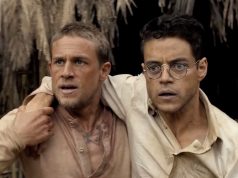People who have seen both the 1974 version of “The Taking of Pelham One Two Three,” a workmanlike thriller with Walter Matthau and Robert Shaw, and the numeralized remake, “The Taking of Pelham 1 2 3,” a generic thriller with Denzel Washington and John Travolta, will probably wonder why this is described as a “remake” at all. The basic concept — terrorists hijack New York City subway train — is all that remains, and it’s not like it’s a terribly inventive premise to begin with. Why not just make another movie about a hijacked subway train? Movies about killer sea animals aren’t necessarily remakes of “Jaws,” after all.
Whatever it is, the new “Pelham” is a pretty ordinary action movie, directed by Tony Scott (“Deja Vu,” “Enemy of the State”) with his usual mixture of senselessly frenetic editing and needlessly profane dialogue. (I noted with amusement that even characters with only one line still manage to squeeze in an F-bomb.) Part of the credit must go to the screenwriter, too, of course: Brian Helgeland (“A Knight’s Tale,” “Man on Fire”), who never met an over-the-top plot he didn’t like.
Washington plays Walter Garber, a Metropolitan Transit Authority official who’s been temporarily demoted to the dispatch desk while he’s investigated for taking a bribe. He’s good at dispatch, though, having worked at this and every other job in the MTA while making his way up the ranks to the ivory tower. It is during one of his shifts on the dispatch desk that the Pelham 123 train (so named because it leaves Pelham Bay at 1:23 p.m.) stops between stations and loses radio contact.
The reason is that it has been taken over by a man calling himself Ryder (Travolta) and a small group of armed bad guys. When Ryder deigns to respond to Garber’s increasingly panicked radio messages, he says he wants $10 million from the city of New York, to be delivered in one hour or else he starts shooting passengers. The idea of a less-crowded subway car might be appealing if it were rush hour, but it’s only mid-afternoon. Garber and the MTA figure they’d better do something to prevent the slaughter of subway riders.
Though Scott’s directorial style is such that you’d think every scene, including the opening credits, was a climax, it’s after Ryder makes his demands that the story actually kicks into high gear. The bull-headed, somewhat unpopular mayor (James Gandolfini) is informed. A hostage-negotiation team, led by John Turturro, descends on MTA headquarters, but Ryder refuses to speak to anyone but Garber. Garber’s wife (Aunjanue Ellis) makes a couple of worried phone calls after seeing TV news coverage of the crisis, primarily to remind us that Garber is a Real Person with a Reason To Live.
The film is obsessed with time. Ryder has delivered a one-hour deadline, and Scott frequently uses onscreen titles to remind us how many minutes are left. Predictably, despite this keen interest in time, the film abuses it. Just like TV’s “24,” events that ought to take no less than 15 minutes are accomplished in three. In other cases, a simple two-minute conversation is alleged to have occupied 10 minutes. These are typical conventions of filmmaking, of course, but constantly referring to how much time is left on the clock only draws attention to them. Either follow a realistic timeline, or don’t.
This is the fourth time Denzel Washington has starred in a Tony Scott film but only the first time for John Travolta — and what took so long? Travolta is in full-on crazy mode here, as if competing with Nicolas Cage for Most Enjoyably Insane Actor. Adorned with an absurdly thin goatee and a cross-shaped earring (Ryder is a lapsed Catholic), Travolta hams it up like the big ham-faced goon he is, and I’d be lying if I said it’s not amusing. But that doesn’t make it good: It’s impossible to take him seriously as a villain. And so, while the film is certainly never boring, it never really convinces us that the stakes are very high, either.
The story has been updated for the cell-phone-and-wifi age (yes, even in subway tunnels), and the twists in the original that made viewers smile 35 years ago have been replaced with the more standard “surprises” that are, by now, de rigueur for hostage-crisis thrillers. Washington’s screen presence is powerful, as always, and the movie isn’t a bad way to pass a couple hours, as long as you don’t sit too close to the screen and are inured to a steady barrage of loud dialogue that doesn’t bother to be clever.
C+ (1 hr., 46 min.; )





